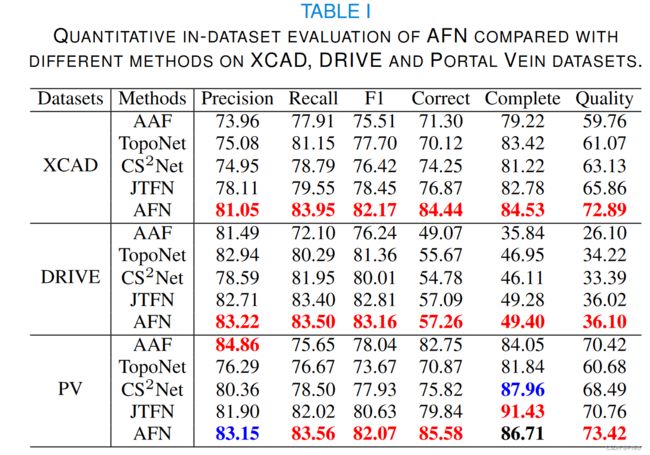Affinity Feature Strengthening for Accurate, Complete and Robust Vessel Segmentation
Affinity Feature Strengthening
-
- 1 DataSets
-
- 1.1 XCAD angiography coronary artery disease
- 1.2 DRIVE retinal vessel seg429 mentation dataset
- 1.3 PV Portal vein vessel dataset
- 1.4 DSA digital subtraction angiography cerebrovas cular vessel
- 2 Data Aaugment
- 3 Initialization
- 4 Comparison
- 4.1 Comparison Range
-
- 4.2 Comparison Results
- 5 Ablation Study
- 6 Other Work
-
- 6.1 Evaluation of vessel segmentation with varying sizes
- 6.2 Robustness to contrast changes
- 6.3 Evaluation of generalizability
- 7 Conclusion
- Core Ways
-
- affinity feature strengthening network(AFN)
- SMAFS_one
- UAFS_three
- Overview of our framework
1 DataSets
1.1 XCAD angiography coronary artery disease
数量 126张,84 training 42 test
分辨率: 512*512
1.2 DRIVE retinal vessel seg429 mentation dataset
数量: 40张 20training 20 test
分辨率: 565*584
1.3 PV Portal vein vessel dataset
属性: in-house
数量: 32张 24training 8test
分辨率: 352**352~448*448
1.4 DSA digital subtraction angiography cerebrovas cular vessel
属性: in-house
数量: 20张
分辨率: 512*512
2 Data Aaugment
水平翻转
随机亮度和对比度范围从 1.0 到 2.1
随机饱和度范围从 0.5 到 1.5
并以 90°、180° 和 270° 随机旋转
然后裁剪为 256×256 像素进行训练
3 Initialization
Optimizer: Adam
lr_Schedule: lr=0.001, Decay=0.0005
Batch_Size: 2
Epoch: 2000
4 Comparison
4.1 Comparison Range
Datasets: XCAD, DRIVE and PV.
Pixel-level: CS2Net
Topology-level: TopoNet
hybrid-level: JTFN
affinity field feature learning: AAF
4.2 Comparison Results
5 Ablation Study
6 Other Work
6.1 Evaluation of vessel segmentation with varying sizes
each thin vessel is assigned with a 5_piexl searching
but each thick use 10-piexl to search
results:

6.2 Robustness to contrast changes
For XCADratio is range [1.7,1.6,1.5,0.9,0.85,0.8], and for DRIVE is range [1.3,1.2,1.1,0.4,0.3,0.2], and the result as follew
Results:

Reasons:
Though image contrast can change across different sit584 uations, the semantic and geometric structure relationships 585 among pixels should be consistent and this information in 586 turn makes AFN more robust against absolute pixel intensity 587 change.
6.3 Evaluation of generalizability
Way:
Apply the models trained on XCAD to the DSA dataset for testing
7 Conclusion
The cores of our AFN are one SMAFS and three UAFS modules which utilize affinity fields to encode semantic relationships as the topology constraint for the segmentation feature enhancement
Core Ways
affinity feature strengthening network(AFN)
SMAFS_one
supervised multi-scale affinity feature strengthening
which use 3*3、 5** 5、9 * 9 pixels to caputer different information.
it is used to combine the last result
UAFS_three
unsupervised affinity feature strengthening
it is deployed to predict affinity relationships aamong pixels in different layers for feature enhancement, each VGG16 layer correspond UAFS.
it only in the 3*3 scale to fuse the segmentation features


